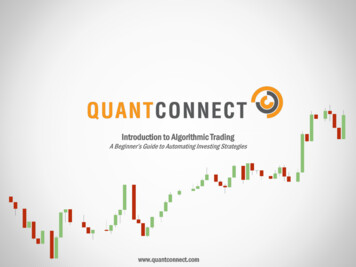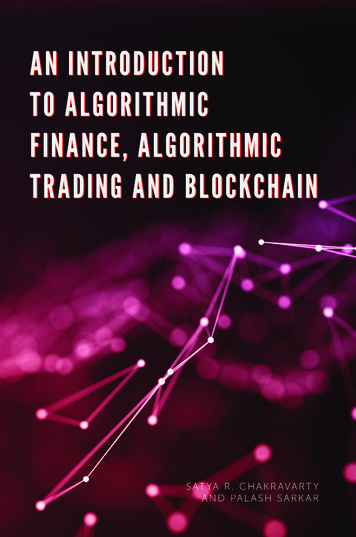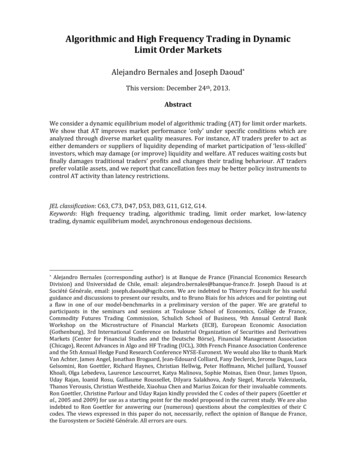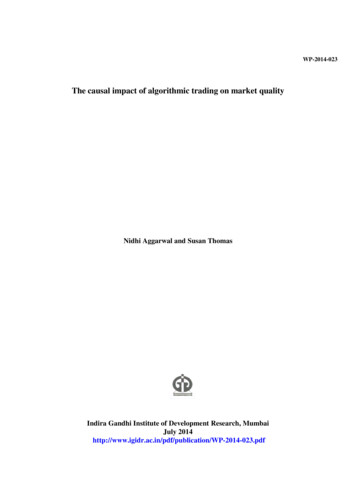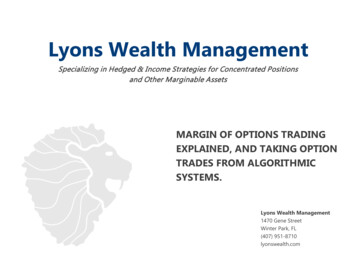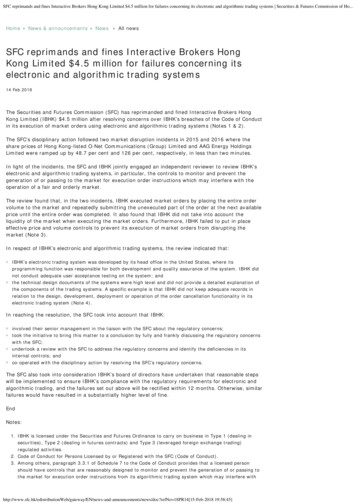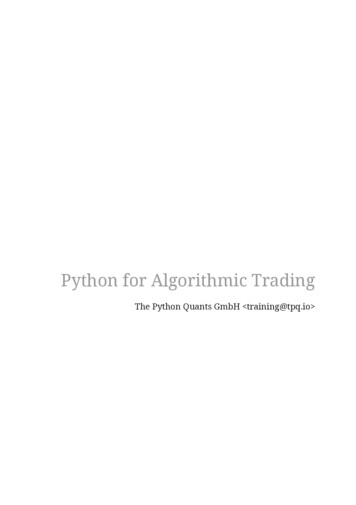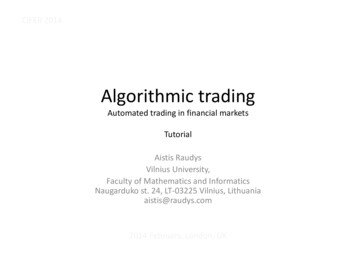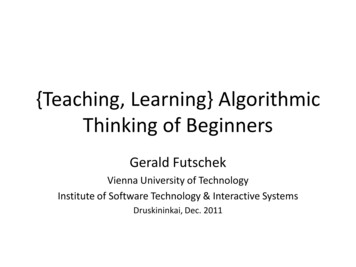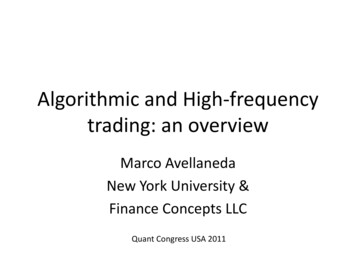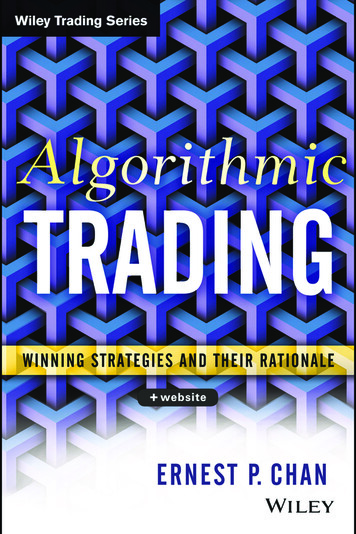
Transcription
ALGORITHMIC TRADING
Founded in 1807, John Wiley & Sons is the oldest independent publishing company in the United States. With offices in North America, Europe,Australia, and Asia, Wiley is globally committed to developing and marketing print and electronic products and services for our customers’professional and personal knowledge and understanding.The Wiley Trading series features books by traders who have survivedthe market’s ever changing temperament and have prospered—someby reinventing systems, others by getting back to basics. Whether anovice trader, professional, or somewhere in-between, these books willprovide the advice and strategies needed to prosper today and well intothe future.For a list of available titles, visit our website at www.WileyFinance.com.
ALGORITHMICTRADINGWinning Strategies andTheir RationaleErnest P. Chan
Cover image: Oleksiy Lebedyev/istockCover design: WileyCopyright 2013 by Ernest P. Chan. All rights reserved.Published by John Wiley & Sons, Inc., Hoboken, New Jersey.Published simultaneously in Canada.No part of this publication may be reproduced, stored in a retrieval system, or transmitted in any formor by any means, electronic, mechanical, photocopying, recording, scanning, or otherwise, except aspermitted under Section 107 or 108 of the 1976 United States Copyright Act, without either the priorwritten permission of the Publisher, or authorization through payment of the appropriate per-copy fee tothe Copyright Clearance Center, Inc., 222 Rosewood Drive, Danvers, MA 01923, (978) 750-8400, fax(978) 646-8600, or on the Web at www.copyright.com. Requests to the Publisher for permission shouldbe addressed to the Permissions Department, John Wiley & Sons, Inc., 111 River Street, Hoboken, NJ07030, (201) 748-6011, fax (201) 748-6008, or online at www.wiley.com/go/permissions.Limit of Liability/Disclaimer of Warranty: While the publisher and author have used their best effortsin preparing this book, they make no representations or warranties with respect to the accuracyor completeness of the contents of this book and specifically disclaim any implied warranties ofmerchantability or fitness for a particular purpose. No warranty may be created or extended by salesrepresentatives or written sales materials. The advice and strategies contained herein may not be suitablefor your situation.You should consult with a professional where appropriate. Neither the publisher norauthor shall be liable for any loss of profit or any other commercial damages, including but not limited tospecial, incidental, consequential, or other damages.For general information on our other products and services or for technical support, please contact ourCustomer Care Department within the United States at (800) 762-2974, outside the United States at(317) 572-3993 or fax (317) 572-4002.Wiley publishes in a variety of print and electronic formats and by print-on-demand. Some materialincluded with standard print versions of this book may not be included in e-books or in print-on-demand.If this book refers to media such as a CD or DVD that is not included in the version you purchased,you may download this material at http://booksupport.wiley.com. For more information about Wileyproducts, visit www.wiley.com.Library of Congress Cataloging-in-Publication Data:Chan, Ernest P., 1966–Algorithmic trading : winning strategies and their rationale / Ernest P. Chan.pages cm. — (Wiley trading series)Includes bibliographical references and index.ISBN 978-1-118-46014-6 (cloth)1. Investment analysis. 2. Stocks. 3. Exchange traded funds. 4. Algorithms.5. Program trading (Securities) I. Title.HG4529.C443 2013332.63’2042—dc232013008380Printed in the United States of America.10 9 8 7 6 5 4 3 2 1
To my parents, Hung Yip and Ching, and my partner, Ben
CONTENTSPrefaceCHAPTER 1 Backtesting and Automated Executionix1CHAPTER 2 The Basics of Mean Reversion39CHAPTER 3 Implementing Mean Reversion Strategies63CHAPTER 4 Mean Reversion of Stocks and ETFs87CHAPTER 5 Mean Reversion of Currencies and Futures107CHAPTER 6 Interday Momentum Strategies133CHAPTER 7 Intraday Momentum Strategies155CHAPTER 8 Risk Management169ConclusionBibliographyAbout the AuthorAbout the WebsiteIndex187191197199201vii
P R E FA C EThis book is a practical guide to algorithmic trading strategies that can bereadily implemented by both retail and institutional traders. It is not anacademic treatise on financial theory. Rather, I hope to make accessible tothe reader some of the most useful financial research done in the past fewdecades, mixing them with insights I gained from actually exploiting someof those theories in live trading.Because strategies take a central place in this book, we will cover a widearray of them, broadly divided into the mean-reverting and momentumcamps, and we will lay out standard techniques for trading each category ofstrategies, and equally important, the fundamental reasons why a strategyshould work. The emphasis throughout is on simple and linear strategies,as an antidote to the overfitting and data-snooping biases that often plaguecomplex strategies.In the mean-reverting camp, we will discuss the multiple statistical techniques (augmented Dickey-Fuller [ADF] test, Hurst exponent, Variance Ratio test, half-life) for detecting “time series” mean reversion or stationarity,and for detecting cointegration of a portfolio of instruments (cointegratedaugmented Dickey Fuller [CADF] test, Johansen test). Beyond the mechanical application of these statistical tests to time series, we strive to convey anintuitive understanding of what they are really testing and the simple mathematical equations behind them.We will explain the simplest techniques and strategies for trading meanreverting portfolios (linear, Bollinger band, Kalman filter), and whether using raw prices, log prices, or ratios make the most sense as inputs to thesetests and strategies. In particular, we show that the Kalman filter is usefulix
PREFACExto traders in multiple ways and in multiple strategies. Distinction betweentime series versus cross-sectional mean reversion will be made. We will debate the pros and cons of “scaling-in” and highlight the danger of data errorsin mean-reverting strategies, especially those that deal with spreads.Examples of mean-reverting strategies will be drawn from interday andintraday stocks models, exchange-traded fund (ETF) pairs and triplets,ETFs versus their component stocks, currency pairs, and futures calendar and intermarket spreads. We will explain what makes trading some ofthese strategies quite challenging in recent years due to the rise of darkpools and high-frequency trading. We will also illustrate how certain fundamental considerations can explain the temporary unhinging of a hithertovery profitable ETF pair and how the same considerations can lead one toconstruct an improved version of the strategy. When discussing currencytrading, we take care to explain why even the calculation of returns mayseem foreign to an equity trader, and where such concepts as rollover interest may sometimes be important. Much emphasis will be devoted to thestudy of spot returns versus roll returns in futures, and several futures trading strategies can be derived or understood from a simple mathematicalmodel of futures prices. The concepts of backwardation and contango willbe illustrated graphically as well as mathematically. The chapter on meanreversion of currencies and futures cumulates in the study of a very specialfuture: the volatility (VX) future, and how it can form the basis of somequite lucrative strategies.In the momentum camp, we start by explaining a few statistical tests fortimes series momentum. The main theme, though, is to explore the fourmain drivers of momentum in stocks and futures and to propose strategiesthat can extract time series and cross-sectional momentum. Roll returns infutures is one of those drivers, but it turns out that forced asset sales andpurchases is the main driver of stock and ETF momentum in many diversecircumstances. Some of the newer momentum strategies based on newsevents, news sentiment, leveraged ETFs, order flow, and high-frequencytrading will be covered. Finally, we will look at the pros and cons of momentum versus mean-reverting strategies and discover their diametricallydifferent risk-return characteristics under different market regimes in recent financial history.I have always maintained that it is easy to find published, supposedlyprofitable, strategies in the many books, magazines, or blogs out there,but much harder to see why they may be flawed and perhaps ultimatelydoomed. So, despite the emphasis on suggesting prototype strategies, we
xiPREFACEwill also discuss many common pitfalls of algorithmic trading strategies,which may be almost as valuable to the reader as the description of thestrategies themselves. These pitfalls can cause live trading results to divergesignificantly from their backtests. As veterans of algorithmic trading willalso agree, the same theoretical strategy can result in spectacular profits andabysmal losses, depending on the details of implementation. Hence, in thisbook I have lavished attention on the nitty-gritties of backtesting and sometimes live implementation of these strategies, with discussions of conceptssuch as data-snooping bias, survivorship bias, primary versus consolidatedquotes, the venue dependence of currency quotes, the nuances of short-saleconstraints, the construction of futures continuous contracts, and the use offutures closing versus settlement prices in backtests. We also highlight someinstances of “regime shift” historically when even the most correct backtestwill fail to predict the future returns of a strategy.I have also paid attention to choosing the right software platform forbacktesting and automated execution, given that MATLAB , my favoritelanguage, is no longer the only contender in this department. I will surveythe state of the art in technology, for every level of programming skills, andfor many different budgets. In particular, we draw attention to the “integrated development environment” for traders, ranging from the industrialstrength platforms such as Deltix to the myriad open-source versions suchas TradeLink. As we will explain, the ease of switching from backtestingto live trading mode is the most important virtue of such platforms. Thefashionable concept of “complex event processing” will also be introducedin this context.I covered risk and money management in my previous book, which wasbuilt on the Kelly formula—a formula that determines the optimal leverage and capital allocation while balancing returns versus risks. I once againcover risk and money management here, still based on the Kelly formula,but tempered with my practical experience in risk management involvingblack swans, constant proportion portfolio insurance, and stop losses. (U.S.Supreme Court Justice Robert H. Jackson could have been talking aboutthe application of the Kelly formula when he said we should “temper its doctrinaire logic with a little practical wisdom.”) We especially focus on findingthe optimal leverage in realistic situations when we can no longer assumeGaussian distribution of returns. Also, we consider whether “risk indicators”might be a useful component of a comprehensive risk management scheme.One general technique that I have overlooked previously is the use ofMonte Carlo simulations. Here, we demonstrate using simulated, as opposed
PREFACExiito historical, data to test the statistical significance of a backtest as well as toassess the tail risk of a strategy.This book is meant as a follow-up to my previous book, QuantitativeTrading. There, I focused on basic techniques for an algorithmic trader, suchas how to find ideas for new strategies, how to backtest a strategy, basicconsiderations in automating your executions, and, finally, risk managementvia the Kelly formula. Yes, a few useful example strategies were sprinkledthroughout, but those were not the emphasis. If you are completely newto trading algorithmically, that is a good book to read. Algorithmic Trading,however, is all about strategies.All of the examples in this book are built around MATLAB codes, andthey are all available for download from www.wiley.com/go/algotradingor my website at www.epchan.com/book2. Readers will find the passwordembedded in the first example. Readers unfamiliar with MATLAB maywant to study the tutorial in Quantitative Trading, or watch the free webinars on mathworks.com. Furthermore, the MATLAB Statistics Toolbox wasoccasionally used. (All MATLAB products are available as free trials fromMathWorks.)Software and mathematics are the twin languages of algorithmic trading.Readers will find this book involves somewhat more mathematics than myprevious one. This is because of my desire to inject more precision in discussing the concepts involved in financial markets, and also because I believeusing simple mathematical models for trading can be more advantageousthan using the usual “data-mining” approach. That is to say, instead of throwing as many technical trading indicators or rules at a price series to seewhich indicator or rule is profitable—a practice that invites data-snoopingbias—we try to distill the fundamental property of that price series usinga simple mathematical model. We can then exploit that model to our financial benefit. Nevertheless, the level of mathematics needed in the trading ofstocks, futures, and currencies is far lower than that needed in derivativestrading, and anyone familiar with freshman calculus, linear algebra, and statistics should be able to follow my discussions without problems. If you findthe equations too confusing, you can just go straight to the examples and seetheir concrete implementations as software codes.When I wrote my first book, I was an independent trader, though onewho had worked in the institutional investment management industry formany years. In the subsequent years, I have started and managed two hedgefunds, either with a partner or by myself. I have survived the 2007 summerquant funds meltdown, the 2008 financial crisis, the 2010 flash crash, the
2011 U.S. federal debt downgrade, and the 2011–2012 European debt crisis. Therefore, I am more confident than before that my initial approach toalgorithmic trading is sound, though I have certainly learned much more inthe interim. For instance, I have found that it is seldom a good idea to manually override a model no matter how treacherous the market is looking; thatit is always better to be underleveraged than overleveraged, especially whenmanaging other people’s money; that strategy performance often meanreverts; and that overconfidence in a strategy is the greatest danger to usall. One learns much more from mistakes and near-catastrophes than fromsuccesses. I strove to record much of what I have learned in the past fouryears in this book.My fund management experience has not changed my focus on the serious retail trader in this book. With sufficient determination, and with someadaptations and refinements, all the strategies here can be implemented byan independent trader, and they do not require a seven-figure brokerage account, nor do they require five-figure technology expenditure. My messageto these traders is still the same: An individual with limited resources andcomputing power can still challenge powerful industry insiders at their owngame.xiiiBooks written by traders for other traders need to answer one basic question: Why are they doing it? More specifically, if the strategies described areany good, why would the trader publicize them, which would surely renderthem less profitable in the future?To answer the second question first: Many of the strategies I willdescribe are quite well known to professional traders, so I am hardlythrowing away any family jewels. Others have such high capacities thattheir profitability will not be seriously affected by a few additional traders running them. Yet others have the opposite properties: They are ofsuch low capacity, or have other unappealing limitations that I no longerfind them attractive for inclusion in my own fund’s portfolio, but theymay still be suitable for an individual trader’s account. Finally, I willoften be depicting strategies that at first sight are very promising, butmay contain various pitfalls that I have not fully researched and eliminated. For example, I have not included transaction costs in my examplebacktest codes, which are crucial for a meaningful backtest. I often usePREFACE The Motive
in-sample data to both optimize parameters and measure performance,which would surely inflate results. I am committing all these pitfallsin my examples because the simplified version is more illustrative andreadable. These may be called “prototype strategies.” They are not meantto be traded “as-is,” but they are useful as illustrations of common algorithmic trading techniques, and as inspirations for the reader to furtherrefine and improve them.What about the basic motive question? It comes down to this:Crowdsourcing knowledge is often more efficient than any other methodfor gathering information. And so—as with my first book—I welcome yourfeedback on the strategies discussed in this book. A Note about Sources andAcknowledgmentsPREFACExivNaturally, I did not invent most of the materials presented here. Besides thetraditional and commonly accessible sources of books, academic journals,magazines, blogs, and online trader forums (such as elitetrader.com andnuclearphynance.com), there are now new online expert networks such asHightable.com and Quora.com where specific questions can be posted andoften answered by true industry experts. I have personally benefited fromall these sources and am grateful to the various online experts who haveanswered my questions with unexpected depth and details.By virtue of my previous book and my blog (http://epchan.blogspot.com), I am also fortunate to have heard from a great many insightful readers, many of whom have contributed to my knowledge base.I have also taught regular workshops in London and Singapore on varioustopics in algorithmic trading that were attended by many institutional analysts and traders. They have contributed valuable insights to me that may notbe easily accessible in any public forums. Special workshops held for clientsin Canada, China, Hong Kong, India, South Africa, and the United Stateshave also exposed me to broad international perspectives and concerns.I am also privileged to have collaborated with many knowledgeable finance professionals even as an independent trader and fund manager. Someof these collaborations are short-term and informal, while others lead tothe formal formation of fund management companies. In particular, I thankSteve Halpern and Roger Hunter for their extensive discussions and countless joint projects and ventures.
I am indebted to Bryan Downing for introducing me to some of the trading technologies mentioned in Chapter 1, and to Rosario Ingargiola forshowcasing his FXOne platform to me.Finally, many thanks to my editor Bill Falloon at John Wiley & Sons forbeing always enthusiastic and supportive of my book ideas, to developmenteditor Meg Freeborn for her unfailingly valuable suggestions, and to production editor Steven Kyritz for shepherding this book to its final form.xvPREFACE
CHAPTER 1Backtestingand AutomatedExecutionWhile the focus of this book is on specific categories of strategies andnot on general techniques of backtesting, there are a number of important considerations and common pitfalls to all strategies that need tobe addressed first. If one blithely goes ahead and backtests a strategy without taking care to avoid these pitfalls, the backtesting will be useless. Orworse—it will be misleading and may cause significant financial losses.Since backtesting typically involves the computation of an expected return and other statistical measures of the performance of a strategy, it isreasonable to question the statistical significance of these numbers. We willdiscuss various ways of estimating statistical significance using the methodologies of hypothesis testing and Monte Carlo simulations. In general, themore round trip trades there are in the backtest, the higher will be the statistical significance. But even if a backtest is done correctly without pitfallsand with high statistical significance, it doesn’t necessarily mean that it ispredictive of future returns. Regime shifts can spoil everything, and a fewimportant historical examples will be highlighted.The choice of a software platform for backtesting is also an importantconsideration and needs to be tackled early on. A good choice not only willvastly increase your productivity, it will also allow you to backtest the broadest possible spectrum of strategies in the broadest variety of asset classes.1
And it will reduce or eliminate the chances of committing the aforementioned pitfalls. We will also explain why the choice of a good backtestingplatform is often tied to the choice of a good automated execution platform:often, the best platform combines both functions. The Importance of BacktestingALGORITHMIC TRADING2Backtesting is the process of feeding historical data to your trading strategyto see how it would have performed. The hope is that its historical performance tells us what to expect for its future performance. The importance ofthis process is obvious if you have developed a strategy from scratch, sinceyou would certainly want to know how it has performed. But even if youread about a strategy from a publication, and you trust that the author didnot lie about its stated performance, it is still imperative that you independently backtest the strategy. There are several reasons for this.Often, the profitability of a strategy depends sensitively on the detailsof implementation. For example, are the stock orders supposed to be sentas market-on-open orders or as market orders just after the open? Are wesupposed to send in an order for the E-mini Standard & Poor’s (S&P) 500future just before the 4:00 p.m. stock market closing time, or just beforethe 4:15 p.m. futures market closing time? Are we supposed to use the bidor ask price to trigger a trade, or are we supposed to use the last price? Allthese details tend to be glossed over in a published article, often justifiablyso lest they distract from the main idea, but they can affect the profitability of a live-traded strategy significantly. The only way to pin down thesedetails exactly, so as to implement them in our own automated executionsystem, is to backtest the strategy ourselves. In fact, ideally, our backtesting program can be transformed into an automated execution program bythe push of a button to ensure the exact implementation of details.Once we have implemented every detail of a strategy as a backtest program, we can then put them under the microscope and look for pitfalls inthe backtesting process or in the strategy itself. For example, in backtestinga stock portfolio strategy with both long and short positions, have we takeninto account the fact that some stocks were hard to borrow and cannot easilybe shorted at any reasonable size? In backtesting an intermarket pair-tradingstrategy in futures, have we made sure that the closing prices of the twomarkets occur at the same time? The full list of pitfalls is long and tedious,but I will highlight a few common ones in the section “Common Pitfalls of
Common Pitfalls of BacktestingAlthough almost every strategy allows for unique opportunities in committing errors in backtesting, there are a number of common themes, somegenerally applicable to all markets, others pertain to specific ones.3BACKTESTING AND AUTOMATED EXECUTIONBacktesting.” Often, each market and each strategy presents its own veryspecific set of pitfalls. Usually, a pitfall tends to inflate the backtest performance of a strategy relative to its actual performance in the past, which isparticularly dangerous.Even if we have satisfied ourselves that we have understood and implemented every detail of a strategy in a backtesting program, and that there isno pitfall that we can discover, backtesting a published strategy can still yieldimportant benefits.Backtesting a published strategy allows you to conduct true out-of-sampletesting in the period following publication. If that out-of-sample performanceproves poor, then one has to be concerned that the strategy may have workedonly on a limited data set.This is actually a more important point than peoplerealize. Many authors will claim in their articles that the backtest results were“verified with out-of-sample data.” But, actually, if the out-of-sample testingresults were poor, the authors could have just changed some parameters, orthey could have tweaked the model substantially so that the results look goodwith the “out-of-sample” data. Hence, true out-of-sample testing cannot really begin until a strategy is published and cast in stone.Finally, by backtesting a strategy ourselves, we often can find ways torefine and improve the strategy to make it more profitable or less risky.The backtesting process in trading should follow the “scientific method.” Weshould start with a hypothesis about an arbitrage opportunity, maybe basedon our own intuition about the market or from some published research.We then confirm or refute this hypothesis by a backtest. If the results of thebacktest aren’t good enough, we can modify our hypothesis and repeat theprocess.As I emphasized earlier, performance of a strategy is often very sensitiveto details, and small changes in these details can bring about substantial improvements. These changes can be as simple as changing the look-back timeperiod for determining the moving average, or entering orders at the openrather than at the close. Backtesting a strategy allows us to experiment withevery detail.
Look-ahead BiasAs its name implies, look-ahead bias means that your backtest program is using tomorrow’s prices to determine today’s trading signals. Or, more generally, it is using future information to make a “prediction” at the current time.A common example of look-ahead bias is to use a day’s high or low price todetermine the entry signal during the same day during backtesting. (Beforethe close of a trading day, we can’t know what the high and low price of theday are.) Look-ahead bias is essentially a programming error and can infectonly a backtest program but not a live trading program because there is noway a live trading program can obtain future information. This differencebetween backtesting and a live trading program also points to an obviousway to avoid look-ahead bias. If your backtesting and live trading programsare one and the same, and the only difference between backtesting versuslive trading is what kind of data you are feeding into the program (historicaldata in the former, and live market data in the latter), then there can be nolook-ahead bias in the program. Later on in this chapter, we will see whichplatforms allow the same source code to be used for both backtest and liveexecution.ALGORITHMIC TRADING4Data-Snooping Bias and the Beauty of LinearityData-snooping bias is caused by having too many free parameters that arefitted to random ethereal market patterns in the past to make historical performance look good. These random market patterns are unlikely to recurin the future, so a model fitted to these patterns is unlikely to have muchpredictive power.The way to detect data-snooping bias is well known: We should test themodel on out-of-sample data and reject a model that doesn’t pass the out-ofsample test. But this is easier said than done. Are we really willing to give upon possibly weeks of work and toss out the model completely? Few of us areblessed with such decisiveness. Many of us will instead tweak the model thisway or that so that it finally performs reasonably well on both the in-sampleand the out-of-sample result. But voilà! By doing this we have just turnedthe out-of-sample data into in-sample data.If you are unwilling to toss out a model because of its performance ona fixed out-of-sample data set (after all, poor performance on this out-ofsample data may just be due to bad luck), or if you have a small data setto start with and really need to tweak the model using most of this data,you should consider the idea of cross-validation. That is, you should select a
5BACKTESTING AND AUTOMATED EXECUTIONnumber of different subsets of the data for training and tweaking your modeland, more important, making sure that the model performs well on thesedifferent subsets. One reason why we prefer models with a high Sharpe ratioand short maximum drawdown duration is that this almost automaticallyensures that the model will pass the cross-validation test: the only subsetswhere the model will fail the test are those rare drawdown periods.There is a general approach to trading strategy construction that can minimize data-snooping bias: make the model as simple as possible, with as fewparameters as possible. Many traders appreciate the second edict, but failto realize that a model with few parameters but lots of complicated tradingrules are just as susceptible to data-snooping bias. Both edicts lead to theconclusion that nonlinear models are more susceptible to data-snooping biasthan linear models because nonlinear models not only are more complicatedbut they usually have more free parameters than linear models.Suppose we attempt to predict price by simple extrapolation of the historical price series. A nonlinear model would certainly fit the historical databetter, but that’s no guarantee that it can predict a future value better. Buteven if we fix the number of parameters to be the same for a nonlinearmodel versus its linear contender, one has to remember th
future: the volatility (VX) future, and how it can form the basis of some quite lucrative strategies. . will also discuss many common pitfalls of algorithmic trading strategies, which may be almost as valuable to the reader as the description of the strategies themselves. These pitfalls c

